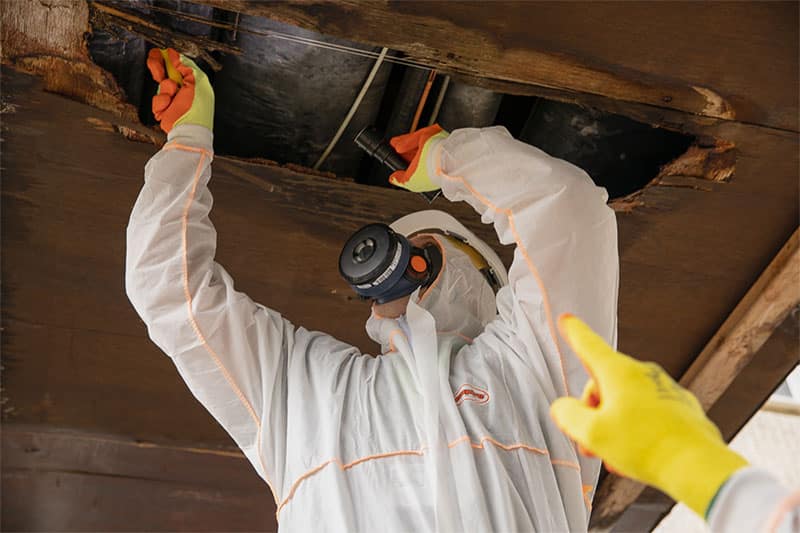What are the common challenges faced by asbestos surveyors?
When it comes to keeping people safe from the dangers of the recognised carcinogen – and now-banned substance – known as asbestos, there can be very few roles as important as that of the asbestos surveyor.
Under the Control of Asbestos Regulations 2012 (CAR 2012), those who are responsible for managing non-domestic buildings are required to take reasonable steps to determine whether there are asbestos-containing materials (ACMs) in the given premises. If ACMs are indeed present, it will also need to be known what the location, amount, and condition of those ACMs are.
As I’ve written about previously, asbestos surveys play a crucial part in helping dutyholders under CAR 2012 to find out the above information about their properties.
There are different types of asbestos survey, including management surveys and refurbishment/demolition surveys. Exactly what happens during the typical asbestos survey therefore depends on the type of survey involved. However, asbestos surveying generally entails the surveyor methodically working around the given site, with the aim of identifying suspected ACMs. Samples are then often taken of these potential ACMs for subsequent laboratory analysis.
Given the strong link between the inhalation (or ingestion) of asbestos and a subsequent elevated risk of asbestos-related disease, such as mesothelioma or asbestos-related lung cancer, it is fair to say that asbestos surveying is highly specialised work, in which ensuring safety is paramount.
Common challenges faced by asbestos surveyors
But what are some of the distinctive challenges that asbestos surveyors tend to face over the course of their day-to-day work? Below, we have set out a few of them.
Lack of access
It might sound like a mundane point to make that asbestos surveyors can sometimes find it difficult to access certain buildings – or parts of buildings – in order to do their work. However, it really is one of the most frequent issues that can arise for asbestos surveyors.
Given that it really is the case that asbestos can be present more-or-less anywhere around a given site, it is crucial to ensure the surveyor that you hire will be able to easily access all areas of your premises.
A common issue is when a surveyor comes up against a locked door for which they don’t have the keys or access code. In these situations, it might be difficult for the surveyor to obtain the necessary cooperation from property owners and occupants.
Such a lack of access can greatly slow down the surveyor’s work. So, you should be doing everything you can to make all areas of your site accessible to them before they arrive on the day.
Hazardous working conditions
You might imagine that it would go without saying that any work involving direct contact with asbestos would be extremely hazardous work. After all, asbestos-related disease continues to be responsible for around 5,000 deaths in the UK every year.
Nonetheless, it is worth emphasising that asbestos surveyors should never be complacent about the health and safety risks the now-banned fibrous silicate mineral can present.
Asbestos really can be present in an extremely wide range of products and locations within a building – such as stud walls and partitions, ceiling tiles, decorative Artex coatings, and many more. And it can be susceptible to deterioration over time, as well as to accidental human disturbance.
So, any responsible asbestos surveyor will adopt sensible measures in recognition of this, including the proper use of personal protective equipment (PPE), and adherence to safety protocols.
Complex and diverse building structures
During its period of peak use throughout the bulk of the 20th century, asbestos appeared in all manner of products used in construction, ranging from soffit boards and insulation products to ceiling tiles, floor tiles, and cement roofing.
With asbestos once having been seen as something of a “wonder material” on the basis of such qualities as its physical strength, fire resistance, and relative availability and affordability, it really did see use in an exceedingly broad range of building types and structures. These included public, domestic, and commercial sites alike.
Although it has not been legal to import and use asbestos in the UK since 1999, much asbestos from before that date remains present in buildings around the country.
This situation heightens the complexity of the asbestos surveyor’s work. They will typically find themselves carrying out surveying work on buildings of many different ages, designs, and construction materials. Some building structures can be complex, with ACMs that are largely hidden or inaccessible, which can make the task of identifying such asbestos materials very difficult.
Sampling and analysis limitations
As I touched on above, a key element of the job of an asbestos surveyor is taking representative samples of materials from the site, and arranging to have them analysed in a laboratory. This is important for ascertaining whether certain suspected ACMs truly do contain asbestos.
That word I mentioned above – “representative” – is really important. Inadequate sampling techniques present the risk that ACMs will not be identified in areas of a building where they are, in fact, present.
Suitably qualified, licensed, and skilled asbestos surveyors will be well-informed on the challenges that can arise in attempting to obtain genuinely representative samples for laboratory analysis. So, choosing a licensed surveyor will help you ensure there are no deficiencies in the quality of the samples that they take.
Interpretation of survey results
The analysis of asbestos samples, too, is a very specialised task. So, only appropriately trained and competent analysts should take on such work, in a suitable analytical laboratory, to help make sure nothing important is missed.
Not only analysis, but also interpretation of the asbestos survey results, will need to take place in order to determine the true nature of asbestos risks the given property poses.
One of the important distinctions to be made here, is between friable and non-friable asbestos-containing materials. The term “friability” refers to the tendency that a given asbestos material has to break down, chip or crumble, as might arise if the ACM is subject to abrasion or pressure.
Friable asbestos, then, is asbestos that is more susceptible to damage, meaning that even relatively light human disturbance could cause the material to be broken. This, in turn, could result in dangerous asbestos fibres being released into the air.
By contrast, non-friable asbestos is asbestos that much more effectively resists damage or abrasion. This means that in the event of being touched by the human hand, this type of asbestos is much less likely to release harmful fibres into the air.
Asbestos surveyors and analysts must therefore be very mindful of these differences when they are attempting to determine the level of risk that various ACMs are likely to present in a building.
Regulatory compliance and documentation
With asbestos having now been banned in the UK for more than two decades, various stringent regulations have sprung up over the years, to help ensure the risks of asbestos are controlled in any premises where the potentially lethal substance is still present.
Legislation such as CAR 2012 sets out various crucial rules and guidelines, including a need to make – and keep up to date – a record of the location and condition of ACMs on a given site.
So, asbestos surveyors must be able to keep up with the ever-evolving asbestos-related regulations and guidelines, while ensuring accurate and comprehensive documentation of survey findings and reports.
An asbestos surveyor achieving consistent compliance in this area will enable them to give their clients – including many dutyholders under the CAR 2012 legislation – the best possible advice, guidance, and service.
Professional development and up-to-date knowledge
Unquestionably, one of the greatest enemies that any asbestos surveyor faces, is complacency. Asbestos surveyors will never cease learning, and they might need to refresh their existing knowledge from time to time.
Any asbestos surveyor therefore must be committed to continuous learning, so that they can keep up to date with the latest industry developments and best practices.
Asbestos surveyors face all manner of very real challenges
The task of carrying out an asbestos survey is certainly not a modest one, or one that anyone can do. It is a very specialised role, for which the most stringent health and safety practices are crucial.
An asbestos surveyor must be highly methodical and scrupulous in their work, including in the identification of suspected ACMs, and the taking of representative samples for analysis in the laboratory. They need to be proactive, too, in keeping up with the relevant regulations and ensuring their industry knowledge is always up to date.
By overcoming these challenges, however, an asbestos surveyor will be in an excellent position to practise effective asbestos management. This, in turn, is imperative for keeping site users, workers, and the wider public safe.
Are you responsible for the management, maintenance, and repair of a given premises, with an interest in ensuring the best possible asbestos survey is carried out on your site? If so, please do not hesitate to send an email to the Oracle Solutions team today, or to call us today to find out more and request your fast and free asbestos quote.

Written by Callum McDonald
Callum McDonald is an expert in asbestos quality management, ensuring rigorous adherence to regulations and high-quality standards in removal projects. His focus on enhancing quality and client satisfaction makes him a crucial asset in safety and compliance within the field. Callum's expertise in technical support and oversight of licensed works underscores his commitment to excellence in asbestos management, providing invaluable guidance to clients in this specialised area.

